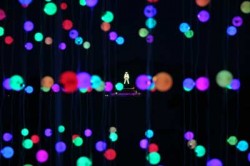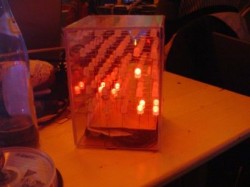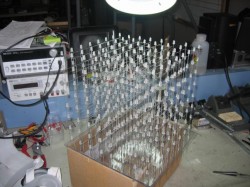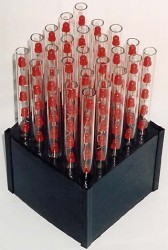|
LED Cubes are interesting. A work of art at rest, and hypnotic experience once the microcontroller takes charge. This cube was created by Chris Lomont and Gene Foulk. Initially prototyped using a PIC microcontroller that was later swapped out in favor of a gumstick controller. “Gene and I started construction on a LED cube. We built a 4x4x4 bicolor prototype over the weekend to help us decide on LED colors, programming interface, etc. Our final cube(s) will be at least 8x8x8, and we contemplate up to 13x13x13 = 2197 LEDs, which would be a tad expensive, not to mention the horrible mess of wiring we’d have to do.” |
|
This video is of the smaller 4X4X4 LED cube. |
|
|
 The Cubatron by Mark Lottor is a huge LED cube. Each pixel is an RGB LED and PIC12F629 microcontroller that is mounted inside a ping pong ball. “The Cubatron is 8x8x8 feet. It is held up by 4 guy wires, one at each of the top corners of the cube. A “fence” 5 feet from each side of the Cubatron keeps people from touching it, as it is fragile. Thus it requires a footprint of approximately 18×18 feet. The Cubatron only operates at night. A small gas generator is located nearby for power.” |
|
|

James Clar has created many LED based systems. His 1000 LED cube is very nicely constructed. While sampling his creations don’t miss the Square Eclipse. Take a look at Modern Contemporary Design for a few images that don’t appear on James Clar’s Web site. “1000 LEDs soldered into a spatial display unit. The 3D cube is a 10 x 10 x 10 freestanding cube matrix with 1000 individually controllable LEDs. Each LED acts as one pixel in the spatial array and can be refreshed at a rate of over 60 frames per second creating a low resolution 3D television.” |
 You can read more information about this project here. Well you can if you speak German 🙂 If you are language challenged like me you will have to settle for looking at nice pictures. |

The creator of this cube is unknown, more pictures can be found at David Wyatt’s Web site. Judging by the pictures this unit has some serious horsepower behind it! Have a look at the processor… |
| Real 642-982 exam preparation with help of latest 642-504 questions and 642-873 answers written by experts so you will pass your exam with highest score guaranteed. |



Permalink
I could see myself having one of these in my living room but the price would have to be right.
Permalink
Yo man these are sweet. Lots of money to build I bet.
Permalink
Lets make a Universal Hologram for Real.
incerely Yours,
Neurohacker@gmail.com
(.~.)
–oOO–(_)–OOo–
learning through repetition or what it really is (brain washing through repetition)
Thats how Toilet training a Human is done!!!!!
The only Fear we have is human stupidity
Psychiatry is just Legal Drug Pushers.
the brain’s total electrical activity corresponds to the information processing in the brain. or as some call the Mind of the Human.
Permalink
Hi Neurohacker,
I could just imagine the number of LEDs needed for a 3D image!
Permalink
Hi,
I like to get started with those cubes. Are there any publications (i.e. algorythms)?
Thanks
Peter
Permalink
Re.
Alan Parekh Says:
April 18th, 2006
Hi Neurohacker,
I could just imagine the number of LEDs needed for a 3D image!
—————————————————————–
Hi
3d or 4d Leds.
Neurohacker
Permalink
Hey Neurohacker,
You lost me at 4D LEDs 🙂
Permalink
RE:Author: Alan Parekh
Comment:
Hey Neurohacker,
You lost me at 4D LEDs 🙂
Well 4 leds would make 3d + Time(4d) in the LED Cubes.
neurohacker@gmail.com
Permalink
Hey Neurohacker, that sounds like a bit more than a weekend project. I think I will have to pass 😉
Permalink
Along time ago many many years ago
Sounds like the start of Stare Wars. Hun
I got this $
Mirage 3-D Instant Hologram maker, three-dimensional real image, holograms, parabolic mirror.
http://www.optigone.com/
Its very cool maybe some one could make a Real Size one and make it fit my T.V.
P.S. if you make it send me a Email ok
Good Day
neurohacker@gmail.com
Permalink
neutrino platform scanner
1) Make a Brain scan with your Brain out of scan(neutrinos capture)=(Template1)
2) Make a Brain scan with your Brain in scan(neutrinos capture)=(Template2)
3) The Difference would be your Brain and (mind) in neutrinos.
4) Then Template2 – Template1 = neutrinos from particles of Brain and mind.
Note The scan is neutrinos(Templates) from our Sun.
neurohacker@gmail.com
Permalink
Photons-atoms interactions
Lets make it REAL.
Brain and (mind) in neutrinos.
Permalink
Photons-atoms interactions
neurohacker@gmail.com
Permalink
You have some huge concepts there neurohacker
Permalink
LIGHT-TO-FREQUENCY
http://www.taosinc.com/
measuring light intensity from the Mirage 3-D
neurohacker
Permalink
The wings of ATOMS
IBM scientists demonstrate single-atom magnetic measurements
http://domino.research.ibm.com/comm/pr.nsf/pages/news.20040909_samm.html
neurohacker@gmail.com
Permalink
These LEDs are one on top of the other in a square layout. I’d like to see them stacked in cubic close packed, aka CCP. CCP is the shape ping pong balls assume naturally when you pile one on another. Molecules do the same. Chemists call it “CCP” or “HCP” (cubic or hexagonal close packing). Bucky Fuller called it IVM (isotropic vector matrix). Type these terms in Google images and see what I mean. I predict CCP display will look more attractive to the human eye. I predict waves will render better with a CCP display, as refraction, reflection and diffraction usually occur angles other than 90 and 45.
Permalink
I visit this page using ‘http://hackedgadgets.com/2006/03/10/led-cubes/’ this time, and the plugin works fine.
Permalink
this is something that I MUST to do!
great cube
I want one of those
Permalink
James Clar is selling his 3D Display cubes at
https://www.jamesclar.com/store/3dcubewhite/index.html
He has one patent and 2 pending on the technology. Check out YouTube for some video where he had 14 arrayed as a large piece of signage.
Permalink
i want led factory! thanks
Permalink
i’d love to see these in noghtclubs
Permalink
can i program pic with asm. can u send it 2 my email
Permalink
Hi Maran,
You will have to click on the link to the cube that you are interested in to go to the creator’s site.
Permalink
some comercial cube: http://www.visualcube.org
Permalink
Cool looking cube, I wonder how much demand there is for that.
Permalink
Hi ,
I would like to receive some saples & catalogues of the LED cubes for a quick reference & would be needing to use these in some of our up comming projects . I would also like to know the feasibilties of custom making these as suited for the projects .
I would appreciate a feedback from you .
Regards
Greg
Permalink
Trippy! Would go well with a lava lamp and some black lights!
Permalink
It’s great to have a 3d leds cube, but it’s better when you put new contents inside 🙂
Let’s see http://www.3dleds.com
Permalink
??????????LED?????????????????LED??????????????2006??????????????????????
Very good ideas, did not expect to make this kind of LED, it is like this site, this LED expert ideas and practical ability are very strong there in 2006? Oh can not think now is a good upgrade for you.